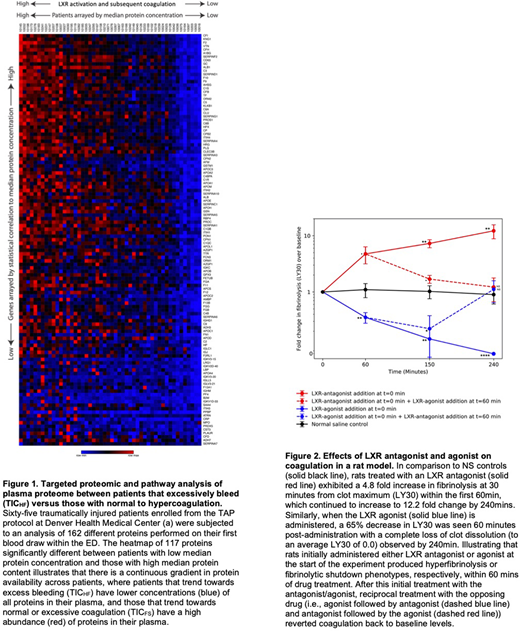Trauma-induced coagulopathy (TIC) manifests as a bimodal disruption of normal fibrinolysis, where at the two extremes, fibrinolytic shutdown (TICFS) places the patient at increased risk for thromboembolism and post-injury multiple organ failure, and systemic hyperfibrinolysis (TICHF) results in excessive bleeding. Plasma proteomic profiles for 65 trauma patients were used to identify changes in the patient's plasma protein profile stratifying them by risk for TIC. A strong correlation was seen between total plasma protein concentration of individual patients and the concentration of coagulation proteins within that patient, suggesting that trauma-induced coagulation may be affected through a mechanism that controls the efflux of many coagulation proteins into the plasma (Figure 1). Pathway analysis, in addition to elucidating changes in the coagulation cascade, identified several proteins that are known to be regulated by the Liver X receptor/Retinoid X receptor (LXR/RXR), suggesting that LXR/RXR-mediated activity may regulate TIC (p=9.03E-26). Validation experiments in a rat model revealed that fibrinolytic response to an LXR antagonist and/or agonist can be observed in less than 60 minutes (Figure 2). Additionally, we show through reciprocal rescue of fibrinolysis that the TIC phenotypes (TICHF and TICFS) are one continuum and are ultimately co-reversible, where the reduced LXR signaling that causes sequestration of blood factors in the liver leading to excess bleeding or induced LXR signaling that causes excess efflux leading to thrombosis can be reversed through administration of the LXR agonist or antagonist, respectively. Thus, as modulation of LXR shows co-reversibility and rapid response, induction/inhibition of the LXR pathway provides a direct and novel therapeutic intervention in severely injured patients at risk for TIC.
No relevant conflicts of interest to declare.
Author notes
Asterisk with author names denotes non-ASH members.


This feature is available to Subscribers Only
Sign In or Create an Account Close Modal